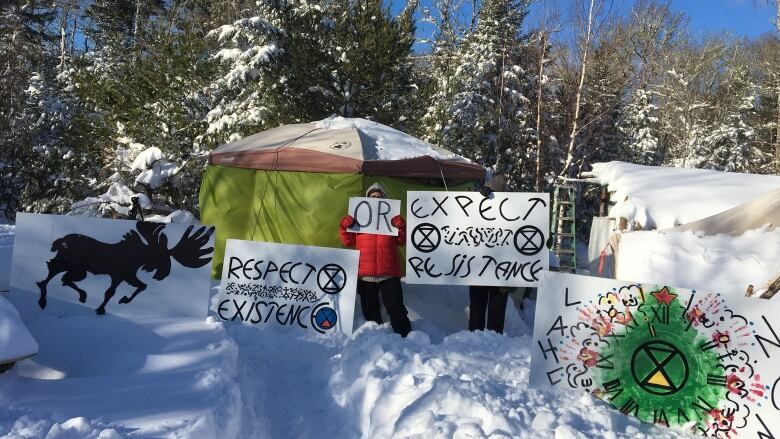Protester says logging should be cancelled after discovery of species at risk
24-hectare area in Annapolis County said to contain rare lichens

People protesting proposed loggingon Crown land in Nova Scotia'sAnnapolis County say their resolve to remain in place has only strengthened following word that species at risk have been discovered at the site.
A protest camp was set up in December in response to a plan that would see about a third of the trees removed from an approximately 24-hectare piece of land between Roxbury and Albany. Despite Natural Resources officials saying the plan represented a new approach to forestry, protesters disagreed.
After protesters were alerted to the possible existence of rare lichens at the site, the Natural Resources Department put a pause on the harvest and sent in a lichenologist on Sunday to examine the site.
Nina Newington, one of the people camping at the site, said the lichenologist told people camping at the site that hissurvey found frosted glass whisker lichen, black-foam lichen and wrinkled shingle lichen. Black-foam and wrinkled shingle are listed as species at risk, while frosted glass whisker is considered rare and sensitive.
Newington said her expectation is there is more to find, but weather conditions and the size of the area limited what could be observed during a single site visit.
"He was there for four hours," she said in a phone interview. "There's over two feet of snow on the ground in the forest."
Findings illustrate problems
Newington said the harvest pause should remain until a proper survey can happen when the bottom of the forest is not covered with snow and it's easier to move around the site. More broadly, shewants the department to start paying more attention to what local people who know the land and have concerns for its future have to say.
"I think as we're finding these rare lichens, it's reinforcing that perception that this is not a forest that should be disturbed;it should be left alone."
People trying to protect the site have argued the land should be left alone because it's an 80-year-old forest largely surrounded by clear cuts, but Newingtonsaid the most recent findings also highlight the inadequacy of the work Natural Resources officials seem to do before signing off on applications by companies to cut on Crown land.
"I don't think the DNR biologists are coming out and looking at these parcels. They're looking at the data that they have from their desks and, whatever you can say about that, it's very clear in this instance that they've missed some very important finds. And that means they need to be thinking about how they do this differently."
Department awaiting results
A spokesperson for the Natural Resources Department said officials had yet to receive or review the information. Buffer zones will be applied to any area where rare lichens are confirmed, in keeping with management practices, before the temporary hold on the harvest approval is lifted.
The spokesperson could not say why the lichens were missed during the initial assessment of the land prior to the cut being approved, nor whether there are concerns that there could be more that the department has yet to find.
Newington said the group of protesters, which includes about 50 people who cycle in and out of the campsite at different times, are committed to the cause and don't plan to move.
"It's kind of a line in the sand for us," she said."You can't keep cutting the remnants of old forest in Nova Scotia. There's too little left."
MORE TOP STORIES












_(720p).jpg)


 OFFICIAL HD MUSIC VIDEO.jpg)
.jpg)



























































































